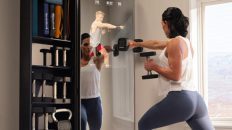Though there are many mindfulness meditations that can help you calm down, even if you struggle with a disability, but yoga is a scientifically proven way to manage your disabilities and emotions. Most people are intimidated at the thought of practising it as they believe that yoga requires a flexible body. That is only a myth.
In reality, you only need a body to practice yoga. There have been studies conducted on yoga being practiced by individuals on wheelchairs, as well as those who suffered from paralysis. Yoga proved to be effective in all the cases. Yoga for people with disabilities is also called ‘Adaptive Yoga’.
Before heading on to the specifics, it is important to define the term disabilities.
What is a Disability?
Disability is defined as the physical or mental condition that impairs a person’s adaptive functioning, including movement, senses, or activities. Some of the examples may include, loss of a limb, loss of vision, intellectual disabilities, ADHD etc.
Now that the definition of disability has been made clear, it’s also important to define yoga.
Disclosure: This post contains affiliate links. When you purchase a service or a product through the links, I sometime earn a commission, at no additional cost to you. Read my full disclosure here.
What Is Yoga?
Yoga originated in India about 5000 years ago and eventually diffused off to other countries. It requires a person to adapt some basic body shapes and positions in order to get relaxed and remain fit. It enhances an individual’s mobility level thereby recommended for people having disabilities.
Since people with disabilities cannot be expected to move their bodies in certain directions, they are directed to practice adaptive yoga which is a targeted exercise to improve flexibility and symptoms.
The main difference between traditional yoga and adaptive yoga is that traditional one is not very personalized for certain conditions, while adaptive yoga can be done by anyone as it is highly customized and targets a specific condition which can help you manage it better.
What is Adaptive Yoga?
People who have disabilities and who cannot move in certain directions or do some poses are directed to do what they can in adaptive yoga. Instead of trying to force their body into one size-fits-all poses, they do what they can. Props like straps, chairs and blankets can be used to accommodate the poses as well.
Adaptive yoga tends to be individualized and taught in smaller groups. They move slowly, but you will be sweating too. Moreover, this type of yoga can help with symptoms like anxiety and stress, along with many others. Adaptive yoga is proven to enable balance and flexibility in your mind and body.
Who is Targeted in Adaptive Yoga?
While we know that adaptive yoga is targeted towards people with disabilities, it is also an umbrella term that can include yoga for specific conditions like sclerosis, physical disabilities and for senior citizens. Adaptive yoga is targeted toward individuals with impaired mobility and balance issues as well. People having paraplegia or tetraplegia can also benefit well from adaptive yoga as it’s main focus is to enhance an individual’s mobility.
Adaptive Yoga Benefits for The Disabled:
Some major advantages of adaptive yoga for the disabled ones include:
- Quality of life –Adaptive yoga significantly enhances an individual’s QOL who are dealing with any psychological or physical disability.
- Improves balance – yoga is beneficial especially for those who have incurred brain injuries and it has been proven to improve balance and movements.
- Sense of community and support – yoga is a great way to gather people, who are going through similar problems, to connect with each other and help one another heal effectively. This can reduce depression and anxiety and make the collective effort better too
- Improves daily functioning – since people with disabilities have impaired functioning one way or the other, yoga can improve this element in terms of social skills, better mood, emotional stability and a lot more.
- Reduces anxiety, relieves stress, and boosts mood – Yoga is a proven way to relax and make yourself focused on the present. It enables a person to let go of negative thoughts and thereby reducing the levels of stress hormones. Also, it increases the levels of happy hormones serotonin making a person mood more joyful and happy.
What Equipment Do You Need For Yoga?
Yoga involves the use of chairs and floor mats which makes it comfortable for people who finds it difficult to get up from floor or move across the chairs.
Since adaptive yoga is personalized, you can ask for additional props to help you do certain poses as well. Your instructor may provide you with some. These include blocks, yoga bolsters, pillows, towels and even blankets which are rolled or folded up. You may also need a yoga strap as a prop. Besides that, in most cases, a sturdy chair is sufficient to be in certain positions for a period of time.
Ways to Modify Your Yoga Poses to Manage a Disability
Indeed, there is a lot of power in yoga. But some poses can be much more fruitful for your issues than the others. Some of the yoga positions and tricks to help you manage a disability are mentioned as follows:
- Chair Yoga For Mobility Issues: Individuals who have mobility problems can modify their yoga positions using a chair. Chair Yoga can be done by anyone who needs weight support, is managing an injury or uses a walker or wheelchair. Some of the poses that you can try would include seated cat cow pose, chair forward fold and chair pigeon pose – all of which can significantly improve your mobility.
- Hatha Yoga for Arthritis Relief: If you suffer from arthritis then a gentle hatha yoga may be your savior. It can not only help with the stiffness, but also relieve your joint pain. You can do it at home by following an online video as well. Besides that, a Hatha yoga may include bridge pose which is modified a cow face pose, along with a tree pose that are modified. All of which, can ease the knots in your muscles and strengthen your body.
- Knee Replacement Surgery Poses: You would know how painful it is when you incur a knee surgery. But yoga can aid in the rehabilitation process when carried out with the doctor’s approval. It can help remove bad posture and can help with your knee problems as well. It can fasten the recovery too. In this, you would be doing low lunge with a blanket, keeping a block between the thighs for a chair pose and bolster under the body for child’s pose.
- Balancing Poses for Traumatic Brain Injury: People who are recovering from a traumatic brain injury would know that it’s not easy to deal with stuff that comes later on. It can leave a negative impact on their wellbeing for the res tof their lives.Apart from that, to help them gain some of their abilities back, yoga can come to rescue. It can not only improve the posture, but also the balance. You may be using props to balance on one leg with the other extended in warrior Ill. You may also be balancing half moon pose or use a strap to assist with a dancer’s pose to open up your shoulders to work on balance.
- Yoga Poses for Vision Impairment: Some of the yoga poses can be very helpful with vision impairment too. It can help in building a stronger and confident life with better physical and mental health. Since the functional impairment is significant, such individuals cannot do some poses or may struggle.However, some poses that are suitable would include standing poses by holding on to a wall or chair and listening to audio or video with instructions. You may also practice a seated and kneeling variation of sun salutations. This can help in bringing more stability into your life.
- Pranayama for Multiple Sclerosis: Another condition that is called a multiple sclerosis can be a troublesome one. People who are diagnosed with the problem can find yoga to be very effective in improving their overall strength, balance, and easing pain.Further more, the breathing practices of yoga—called pranayama—can also help people with this condition to find focus and grounding during an episode. Some poses you can try include, Alternate Nostril Breathing, Lion’s Breath and Cooling Breath which can help you calm down and stay present.
Final Thoughts
Yoga can improve the quality of life significantly and anyone who can breathe, can do yoga! It’s important to modify certain poses in order to manage your symptoms based on your condition too. Equipment like a yoga mat, yoga bolster and straps can be very helpful in doing them at home, otherwise all of them will be provided when you go for the classes. Not only can you socialize that way, but it will improve your adaptive functioning including social and cognitive elements. Yoga can help a person feel empowered, especially those who suffer from a disability.


